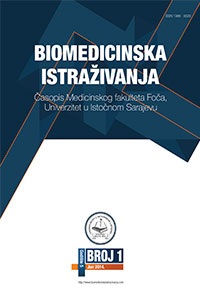Relationship between auditory discrimination of Serbian language phonemes and dysgraphia in different forms of written expression
DOI:
https://doi.org/10.5937/BII2101039MAbstract
Introduction. Writing is the most complex human ability and the
most direct form of communication. Auditory discrimination is the
ability to distinguish different sounds of language. After the age of
seven, difficulties in auditory discrimination, even of similar sounds,
are considered a pathological phenomenon. The aim of the research
was to determine whether difficulties in auditory discrimination of
phonemes are related to the manifestation of dysgraphia in children
of younger school age.
Methods. The research was conducted at the Elementary School
“Vuk Karadzić” in Priboj, during 2020, with the previous consent of the
school principal, as well as the students’ parents. The research sample
included fifty children of the third and fourth grade, aged 9 and 10.
For the purpose of this research, two tests were used: the Phonemic
Discrimination Test (Kostić, Vladisavljević, Popović, 1983) and the Dysgraphic
Handwriting Assessment Test (Ajuriaguerra, Auzias. 1971).
Results. There was no significant difference in achievement in the
Phonemic Discrimination Test between boys and girls. Half of the tested
students achieved the maximum score in the Phonemic Discrimination
Test and they were fairly equal in their achievement in the Phonemic
Discrimination Test. Girls generally had harmoniously developed
handwriting, while more than half of the boys in the categories had
inconsistent handwriting or dysgraphic handwriting when it came to
the forms of dictation, free topic and transcription. No statistically significant
correlations were found between the results in the Phonemic
Discrimination Test and the Dysgraphic Handwriting Assessment Test,
p > 0.05.
Conclusion. Based on the assessment of writing ability and auditory
discrimination in young school children, no statistically significant association
was found between auditory discrimination of sounds and
manifestations of dysgraphic handwriting in all three forms of written
expression (dictation, free topic, transcription).

